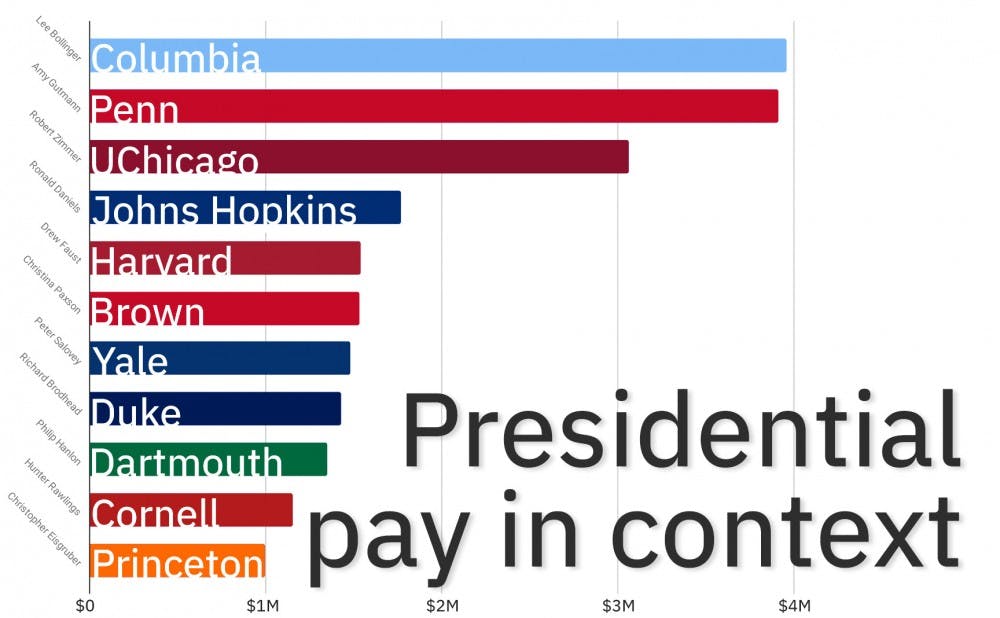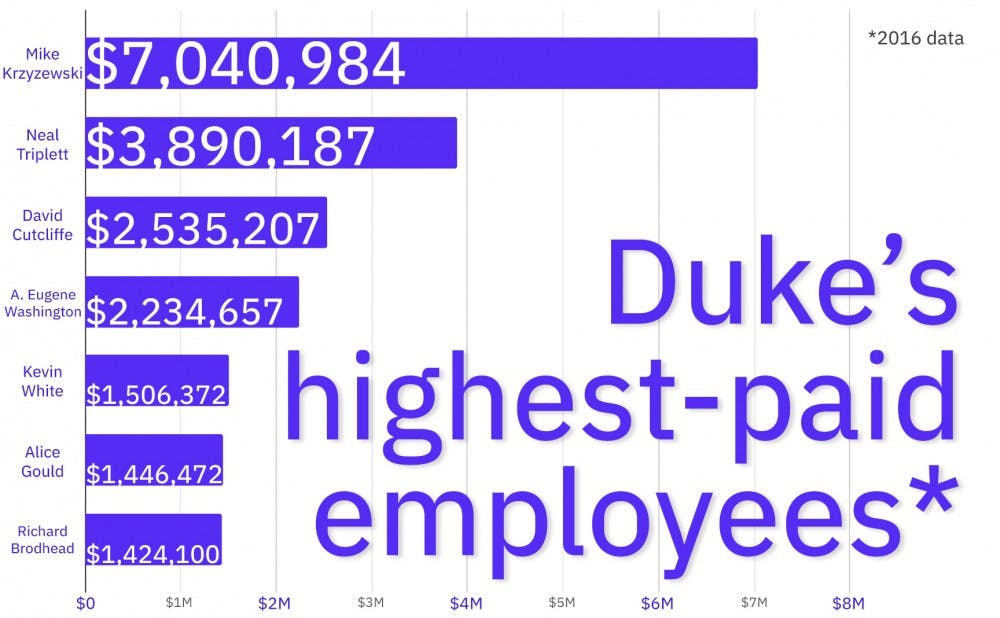With roughly 25 Duke student tuition fees, you could buy a dream home, a Ferrari or pay former President Richard Brodhead’s compensation during his last full year at Duke.
Brodhead made more than $1.4 million in 2016, which was roughly $20,000 increase from his earnings in the prior year, according to records filed with the Internal Revenue Service that recently became public. In total, Brodhead’s yearly compensation nearly tripled from the $500,000 paycheck he received during his first year at Duke in 2004 to his final payday in 2016.
“The university leadership and board go through a rigorous annual process using independent consultants to set and review executive compensation based on responsibilities, performance and the competitive environment,” wrote Michael Schoenfeld, vice president for public affairs and government relations, in an email to The Chronicle.
John Burness, who served as senior vice president for public affairs and government relations from 1991 to 2008, said that the Board of Trustees would approve compensation for officers as part of the annual budget during his time at Duke.
After consulting with independent firms, the president would recommend compensation to the Board, which could then approve or deny the amount—though Burness never recalled an instance where the Board did not accept the president’s recommendation.
Compared to presidents of peer universities, Brodhead fell toward the bottom of the pack in earnings in 2016, according to an analysis by The Chronicle. His compensation earned him eighth place in the group of 11 university presidents, ahead of the leaders at Princeton and Dartmouth and Cornell’s interim president.
Columbia President Lee Bollinger topped the list with $3.95 million—more than 2.5 times what Brodhead collected.
Burness said the discrepancy could be a result of Duke presidents intentionally setting their compensation relatively low.
Former President Nannerl Keohane, who served from 1993 to 2004, would purposefully set her salary at a lower level, even when the Board wanted to pay her more, Burness added.
“She was very conscious, for instance, that there ought to be some relationship between the highest-paid person and the lowest-paid person at the institution, so she intentionally kept her compensation at a relatively lower level than a lot of other presidents,” he said.

Current President Vincent Price, who was then provost at the University of Pennsylvania, made only slightly less than Brodhead in 2016 at $1.28 million in total compensation.
Although Price’s paycheck at Duke is not yet public, Burness told The Chronicle in December 2016 that Price would probably see a bigger paycheck once landing Duke’s presidential gig.
“The president would likely be paid more than a provost, let’s put it that way,” Burness said.
Despite his position at the helm of the University, Brodhead was not the highest-paid official at Duke in 2016. His salary was dwarfed by that of men’s basketball coach Mike Krzyzewski—who made just more than $7 million that year—but some Duke officials without athletic affiliations managed to beat out Brodhead as well.
Neal Triplett, president and CEO at Duke Management Company (DUMAC), made nearly $3.9 million in 2016.
With that paycheck, he earned more than any other listed employee besides Krzyzewski—including football head coach David Cutcliffe and women’s basketball head coach Joanne P. McCallie.
Other DUMAC employees also appeared on the list of Duke’s most highly compensated. Alice Gould also beat out Brodhead’s compensation at $1.45 million as an investment manager who oversaw Duke’s private investments.
Evan Jones, manager of DUMAC’s direct investments portfolio, made $1.34 million in 2016, and Justin Nixon, an investment manager who heads up the public securities team, earned nearly $970,000.
“DUMAC compensation is reviewed and approved by the DUMAC Board of Directors and subject to oversight by the Duke University Board of Trustees,” Schoenfeld wrote. “DUMAC compensation generally includes base compensation as well as incentive compensation linked to investment performance.”
Those at the helm of Duke’s medical operations made millions in 2016.
A. Eugene Washington, chancellor of the health system, was compensated over $2.2 million, a steep increase from the $1.2 million he made in the prior year. Although she has since stepped down from the position, former Dean of the School of Medicine Nancy Andrews netted $1.05 million in 2016.
Not everyone collecting pay from Duke currently works at the University.
Ex-Provost Peter Lange, who was Duke’s longest-serving provost after his tenure from 1999 to 2014, collected nearly $550,000 in 2016. This number stands at around $150,000 less than current Provost Sally Kornbluth’s compensation of roughly $710,000.
Victor Dzau—who stepped down as chancellor of health affairs in 2014—both received more than $140,000 in 2016.
Although Burness did not know the basis of any individual’s compensation, he explained that former officers and deans may continue receiving compensation when they step back into a faculty role.
“It is not uncommon that when [officers and deans] return to the faculty, they receive compensation that is somewhat fair as a result of their having been an officer,” he said.
Dzau is currently the James B. Duke professor of medicine and Lange was a professor with tenure in the political science department and the Sanford School of Public Policy until 2018.
Burness added that administrators could also choose to defer their compensation so that it becomes spaced out during retirement.
Get The Chronicle straight to your inbox
Signup for our weekly newsletter. Cancel at any time.

